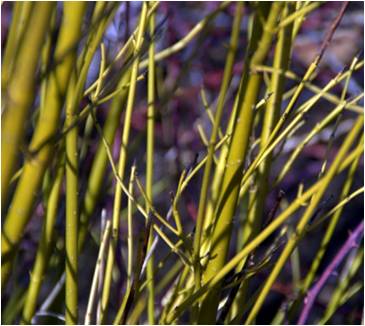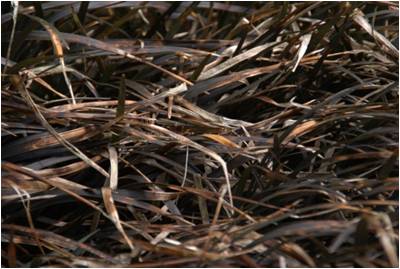The recent early snow is perhaps a good cue to think about the garden’s appearance in winter. It is a common mistake to asume that, once the first frosts come, visual interest in the garden is over until next spring. Winter interest doesn’t just come from flowers (of which there are admittedly rather few) and foliage, but also from attractive stem colouration, dessicated seed heads, and the like.
In summer this border is dominated by the bright yellow-green foliage of the Rubus cockburnianus “Golden Vale” and the variegated Cornus sericea “White Gold”, but it makes its biggest impression in winter, when the contrasting colours are quite striking.

Cornus sericea “White Gold”, Rubus cockburnianus “Golden Vale”, Ophiopogon planiscapus “Nigrescens”, and Calluna vulgaris “Robert Chapman”.
The ‘White Gold’ form has excellent white-edged variegated foliage, and therefore makes a good dual season plant. The foliage colour and effect is also enhanced by a hard pruning regime.
Rubus cockburnianus “Golden Vale” is a handsome and prickly briar with bright golden leaves all summer and in winter, dazzling, chalky white arching stems. The lovely golden yellow foliage makes this an eye-catching ornamental plant in the summer and the white stems give fantastic winter interest.
Ophiopogon planiscapus “Nigrescens” is an evergreen perennial with tufts of glistening strap-like leaves that are closer to black than almost any other plant. The small white or lilac flowers are followed by dark green berries. Makes an excellent foil for contrasting flowers and foliage.
Calluna vulgaris “Robert Chapman” Densely formed low-growing evergreen – a spreading variant of our native Scotch heather. Foliage is golden in spring, turning to orange, then red in winter, with tiny purple flowers in late summer and autumn.
This is just one example, from the Sir Harold Hillier Garden near Romsey, Hampshire, which illustrates how it is possible to achieve year-round interest. There are lots of other plants you could consider, and don’t forget that plants like sedums and Lunaria (Honesty) – with their interesting seedheads that survive all winter – are also really useful.










I like the Honesty seed heads because they can be picked and sprayed gold or silver to make beautiful Christmas table decorations. If dried in their natural state they can also be used in dried flower arrangements or as an unusual interest in the pot pourri bowl. The flowers in summer are a lovely purple and once in the garden can pop up the following year as it self seeds. A truely fresh looking plant with all year interest. Lovely.
Rubus cockburnianus has farinose on the stems which make them look white.
Thanks for the post. It’s easy to get in a winter funk but these are great to look at when it’s cold outside.
When I look at your pics I realise how boring my garden is in the winter. This has inspired me to start a winter planting scheme for next winter.
Thanks for all the great advice!
Best wishes.
T.
Thanks for your comment – it’s always nice to know a post has inspired something positive. Good luck with the scheme